- When writing, it is important to be consistent in verb tense usage.
- There are three basic forms of verb tenses: past, present, and future. Simple and Perfect forms of these verbs are also used.
- The simple form of a verb demonstrates an action that has a specific time duration.
- The action has occurred, is going on now, or will happen in the future.
- The perfect form of a verb is used to show variations in time.
- These variations include ongoing events, a sequence of events, or events that have a continued effect on a situation.
- Perfect tenses include the past, present, or future form of “have” plus the past tense form of the verb.
Each example is followed with an explanation of what the sentence means.
- Simple Past tense:
I jogged to my car.
I jogged to my car and stopped when I got there. The action occurred and ended, and no other events occurred at the same time.
- Past Perfect tense:
I had jogged to my car only to realize I forgot my keys in the office.
I jogged to my car and stopped, but another event (realizing I forgot my keys) occurred directly after the first action.
- Simple Present tense:
I jog to my car.
I jog at a certain point in time and stop. No other actions take place at this time.
- Present Perfect tense:
I have jogged to my car.
I have jogged to my car in the past and the action continues to occur; other actions may take place at the same time.
- Future tense:
I will jog to my car.
I will jog to my car in the future. The action will begin and end during a specific time period.
- Future Perfect tense:
I will have jogged to my car.
At some point in the future I will jog to my car, and other actions may occur at the same time or after the action.
Changing the bold verb to the tense indicated in parentheses:
(Notice how the verbs in the sentence are consistent in tense.)
- She talk__________ (future tense) to her professor about when her paper is due.
- Because she lived alone in an apartment building, she locks____________ (simple past) her doors every night.
- I arrive at the end of the trail and realize I jogged _____________ (present perfect) five miles.
- He got home from the grocery store and realized he spent___________ (past perfect) too much money.
- We ate ________________ (simple present) breakfast with our family every morning.
- After completing this month, I worked _________________ (future perfect) twenty-five years for this hospital.
have jogged
will have worked
You will often use progressive and conditional verb tenses in writing.
- The progressive tense is used to discuss an action that is, has, or will be in the process of occurring.
- These can found in past, present, or future tense.
- Conditional tenses are used to describe an action that depends on another action taking place.
- The word “would” is used to form this phrase.
- You will often find “if” clauses in these sentences.
- Conditional tenses are not used to make predictions or state facts.
Progressive tense:
- She was eating ice cream when her parents came home from work.
Past Progressive : The action happened in the past, and continued to happen when another action occurred.
- Your constant encouragement is helping me while I go through this difficult time.
Present Progressive : The encouragement is going on at the same time as another action, and continues to occur.
- Our professor will be giving a test next week.
Future Progressive : The action has not occurred yet, but will occur in the future at a certain point in time.
Conditional tense:
- If I were in your shoes, I would study for the test before taking it.
Provided that one condition is true (I am in your shoes), another action will occur (I would study). The action test has not occurred yet, but is going to.
- If I had a better understanding of the consequences, I would have thought more before taking action.
This is similar to the above sentence (an action would occur based on a condition), but the action has already occurred and the writer is reflecting back on it.
_______________ My doctor will be leaving for France at the end of the month.
_______________ When the teacher turned the other way, she was cheating on the test.
_______________ I tried to tell her that if I were she, I would take the extra work hours.
_______________ You are driving me crazy by tapping your foot on the floor.
_______________ If she knew the shoes were cheaper at the other store, she would have waited until Saturday to pick them up.
_______________ As he walked into the room, she was cleaning his mess up.
Progressive
Conditional
Sometimes in writing, it is necessary to shift verb tenses. It is important to understand how to do this so you do not confuse your reader.
Keeping a few simple things in mind, you will be able to communicate accurately a timeline of events to your reader…
- Try to stay in the same tense throughout the sentence. This includes variations of the tenses, such as simple, perfect, or progressive.
- Make the order of events clear. Perfect tenses often come before simple tenses.
- You may move forward in time within the sentence if it is necessary to change tenses (past to present or future, present to future).
- Only move backward in time if it makes sense.
- I was walking the dog when she stopped to ask me for directions.
Past progressive and past tense are illustrated here.
A continuous action (walking the dog) is interrupted by an action that occurred once (she stopped to ask directions).
- He has been playing baseball for ten years, and is still playing today.
Past perfect and present progressive are illustrated here.
An action that began in the past (playing baseball) continues to the present (still playing).
- Susan did her homework last week, and will do it this week as well.
Past tense and future tense are illustrated here.
An action occurred once in the past, and it is going to occur again (once) in the future).
- She is writing an article about what happened during the game.
Present progressive and past tense are illustrated here.
A continuous action is occurring in the present, and something in the past is related to this event (the game).
See how the sentences are corrected:
Incorrect: My arm is hurting when I went in to see the doctor.
Correct: My arm was hurting when I went in to see the doctor.
Incorrect: I love to play the piano as a young girl, and continue to play as an adult.
Correct: I loved to play the piano as a young girl, and continue to play as an adult.
Incorrect: I would not have taken the first exit if I know the second exit brought me closer to my destination.
Correct: I would not have taken the first exit if I knew the second exit brought me closer to my destination.
Incorrect: The professor was considering retirement until he find out he could not afford it.
Correct: The professor was considering retirement until he found out he could not afford it.
Incorrect: She became a mother when she will have been twenty-five years old.
Correct: She became a mother when she was twenty-five years old.
Incorrect: Her mother told her to clean her room, but she is walking out of the house.
Correct: Her mother told her to clean her room, but she was walking out of the house.


Verb To Be PowerPoints
Download these PowerPoints about the verb ‘to be’ and use them in class today! These PPTs are great for lessons teaching about the verb to be in the present and past tense. ‘To be’ is an irregular verb, and so its form is very different from other verbs in English. The verb ‘to be’ appears very often in English so it is important for students to learn the different forms of this ‘be verb’. The PowerPoint lessons below include the present tense of the verb to be ( am, are, is ) and the past simple form of the verb to be ( was, were ).
Verb To Be PPT 1: Present Tense
Verb to be ppt 2: past simple tense.

3. Verb Forms and Tenses
Mar 31, 2019
110 likes | 345 Views
3. Verb Forms and Tenses. Three important forms. Verbs in English have different forms which are used in the construction of tenses. Three of the most important forms of any verb are the base form : the “name” of the verb (e.g. be ) the past tense form: used in the simple past tense
Share Presentation
- future perfect
- psychology course
- tense forms
- simple past tense
- present form
- progressive present

Presentation Transcript
Three important forms Verbs in English have different forms which are used in the construction of tenses. • Three of the most important forms of any verb are • the base form: the “name” of the verb (e.g. be) • the past tense form: used in the simple past tense (to be discussed in just a minute) • the past participle form used in perfect tenses (to be discussed in just two minutes!)
The base form The base form of the verb is the “dictionary listing” form, e.g. be or have. • Most verbs also use the base form as one of the present tense forms of the verb • for instance, have is not only the base form of the verb but also a simple present tense form.
The past tense and past participle forms Fortunately, most English verbs have a single form that is used as both the simple past tense and also the past participle forms. In the case of regular verbs, this is the -edform. For example - the the past form of alarm is alarmed. The lion’s roar alarmed the child. - the past participle form is also surprised. The lion’s roar has alarmed several adults, too. The parents comforted their alarmed child.
The past and past participle forms 2 A number of irregular verbs also have the same past tense and past participle form. These irregular forms are unpredictable and must be learned by heart. For example, the past tense of sweep is swept. She swept the floor thoroughly. The past participle form of sweep is also swept. The floor has been thoroughly swept. The swept floor made the room look much more inviting.
Simple present and past tenses • Simple Present: used to show actions, states or events that are true in general • Water boils at 100C. • Also used to show habits. • I drink coffee but Sarah drinks tea. • Simple Past: Used to express an action, event, or state occurring at a time in the past. • The time can be general or specific. • I wanted a muffin. (general) • I wanted a muffin for breakfast this morning. (specific)
Progressive present and past tenses • Present Progressive: used to show actions or events in progress at the moment. The event is not finished. • The form is be (present form) + verb-ing • John is looking for a new bike. • We don`t usually use the progressive with non action verbs: • I want a new iPod. NOT I`m wanting a new iPod. • Past Progressive: Used to express an action that was in progress at a time in the past. • The form is be (past form) + verb-ing • She was sleeping when the baby started to cry.
Perfect present and past tenses Present Perfect: used to show actions that started sometime in the past (time is not important). • Some actions may continue in the present time and some may be completed. • The form is have + past participle verb • I have lived in Ottawa for 2 years. (continuing) • She has eaten at that restaurant. (completed) Past Perfect: Used to express and action that is finished at a time in the past. The time is not important. • The form is had + past participle verb • Tom had finished eating when his friends arrived.
Perfect progressive present and past tenses Present Perfect Progressive: Used to show actions that started sometime in the past (time is not important) and are continuing in the present. • The action is not yet finished. • The form is have + been + verb-ing • They have been working with the government since 2006. Past Perfect Progressive: Used to show that an action was in progress in the past until another action interrupted it. • Used to tell the duration or length of time of the first event. • The form is had + been + verb-ing • She had been working (in progress) for five hours before she took a coffee break (interruption).
Future tenses • Although future tenses are not used frequently in academic writing, they will be covered briefly below. • Simple Future: Used to show that an event will occur at a time in the future. • The form is: will + verb • Valerie will go to Spain next month. • Future Progressive: Used to describe an activity that will be in progress at a time in the future. • There are two forms: will + be + verb-ing be going to + be + verb-ing • He will be taking a psychology course next month.
Future Perfect: Used to express an activity that will be completed before another time or event in the future. • There are two events. The first event is expressed in future perfect. The second event is expressed in simple present. • By the time you read (second event) my email, I will have been to Japan (first event). Future Perfect Progressive: shows an action that will be in progress before another time or event in the future. It emphasizes the duration of the event. • The form is: will + have been + verb-ing • When Professor Jones retires next month, he will have been teaching for 45 years.
- More by User
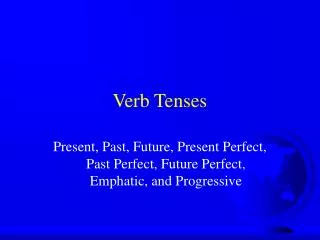
Verb Tenses
Verb Tenses. Present, Past, Future, Present Perfect, Past Perfect, Future Perfect, Emphatic, and Progressive. Present Tense. Something that is happening now. Today I…….sing, dance, eat, etc. I am a student . I like strawberry pie with whipped cream. I walk three miles every day.
607 views • 22 slides

Verb Tenses. Verb tenses tell us when things happen. Events can happen in the Past Present Future. Verb Tenses. Present Past I play (simple) I played (simple) I am playing (continuous) I was playing (continuous). The wonderful ‘was’. The word ‘was’ Will change
642 views • 15 slides

Verb Tenses. By: Mrs. S. Irizarry. “On Your Own”:. Is the tense of each underlined verb present, past, or future? 1.) The Olympic games started in ancient Greece. 2.) Today’s Olympics developed from Greek festivals. 3.) Until the seventy-seventh festival, the games lasted only one day.
943 views • 11 slides

Verb Tenses. Today’s Objective: We will identify three verb tenses:. Present Past Future. What is a verb?. Hmm…what’s a verb?. A verb is a word used to show:. An action. A condition. A state of being. Verb Tenses .
1.39k views • 25 slides

Verb tenses
Verb tenses. Past, Present, Future. Verb tenses. The tense of a verb allows the reader to know if the action took place is the past, present, or will occur in the future. Usually verbs follow a predictable pattern of endings. These are called regular verbs. Past ( ed )
542 views • 10 slides

Verb Tenses. What you need to know…. Tense = TIME There are six tenses that you use every day in your speaking and writing. These six tenses are: present tense past tense f uture tense present perfect tense past perfect tense future perfect tense. .
708 views • 21 slides

Verb Tenses. 6 tenses and the four principal parts of verbs. Verb Tenses . A verb tense is a form of a verb that shows the time of an action or a condition. Each tense has a basic and progressive form. The six tenses are: Present Past Future Present perfect Past perfect
1.16k views • 9 slides

Verb Tenses. Week 8 March 17 th , 2014. The Plan. Objectives Review Introduction Development Practice Game Evaluation. Objectives. Identify which tense to use for the correct expression of time and events Correctly conjugate the verbs tenses; be able to change one tense to another.
700 views • 40 slides

Verb Tenses. Events occur at same time, keep same tense-if not, then change the tenses. Voice. Active Voice-Action is done by its subject Passive Voice-Action done to the subject. Avoid Using the Passive Voice. Why? -less direct -less forceful -less concise
302 views • 12 slides
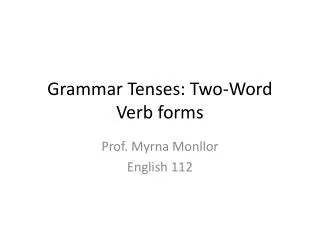
Grammar Tenses: Two-Word Verb forms
Grammar Tenses: Two-Word Verb forms. Prof. Myrna Monllor English 112. Two-Word Verbs. The following tenses are two-word verbs Present progressive Past Progressive Present Perfect Past Perfect Simple Future.
372 views • 10 slides
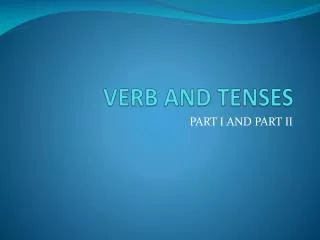
VERB AND TENSES
VERB AND TENSES. PART I AND PART II. VERB AND TENSES. Function: as predicate in a sentence overview: Present, Past, Future Regular and Irregular verb Auxiliary Verb: To be, have, do Modal Simple tenses Progressive tenses Perfect tenses Future tenses. REGULAR AND IRREGULAR. REGULAR:
545 views • 15 slides

Verb Tenses. Perfect Tenses Theme 5 Lesson 24. Verbs. The word tense comes from the Latin word, tempus, which means " time ." The tense of a verb shows the time when an action or condition occurred. There are fourteen tenses in modern English.
779 views • 12 slides

verb Tenses
verb Tenses. Today, we're going to talk about the tenses. Now, if I say "I am beautiful,“ which tense is it? . Obviously it is the past tense. Conson + y = – ies ( study - studies ) O = es ( go – goes ) S, x, ch, sh = es ( watch - watches / mix -mixes ).
1.45k views • 36 slides

Verb Tenses. To Think About Verb Tenses, Use a Time Line. We are stuck in the present. But, we can remember the past and think about the future. We do this with our inner eye. How Does It Work?. Think of this as your inner-eye. This is what we use to remember and to imagine with.
630 views • 26 slides
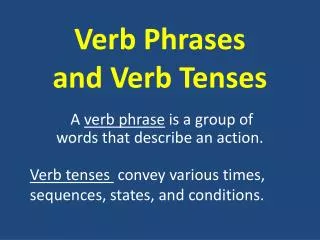
Verb Phrases and Verb Tenses
Verb Phrases and Verb Tenses. A verb phrase is a group of words that describe an action. Verb tenses convey various times, sequences, states, and conditions. Verb Phrases A main verb joined by a h elping verb is a verb phrase. The fans were clapping for the players.
1.01k views • 25 slides

Verb Tenses. Verb tenses tell us when things happen. Events can happen in the Past Present Future. The Past. This is when an event has already happened. I walked across to buy some sweets from the shop. I shouted to my brother in the playground. I ran down the lane with the dog.
382 views • 9 slides

Verb Tenses. Verbs do more than describe an action or state of being. They also tell about TIME! . Different forms of a verb tell whether an action or a state of being takes place in the …. The PRESENT. The PAST. The FUTURE. Present Tense.
506 views • 20 slides

Verb Tenses. Why do we have tenses?. From the Purdue OWL:
330 views • 25 slides

Verb Tenses. How to distinguish different verb tenses when teaching. WHY THE TOPIC?. During the tutoring session, I believe that many learners often write their essays with wrong verb tenses. IMPORTANCE FOR CORRECT VERB TENSES. Clear and easy to understand Consistency
994 views • 66 slides

284 views • 15 slides
- International
- Education Jobs
- Schools directory
- Resources Education Jobs Schools directory News Search

VERB FORMS IN TENSES: PPT PRESENTATION
Subject: English language learning
Age range: 7-11
Resource type: Lesson (complete)
Last updated
20 August 2020
- Share through email
- Share through twitter
- Share through linkedin
- Share through facebook
- Share through pinterest

A ready to use lesson presentation that presents teaching and learning resources on tenses and verb forms.
After completing this lesson, the students will be able to:
- Determine the structure of the verb forms in tenses.
- Relate verb forms in tenses to person and number.
- Demonstrate tense formulation and usage in writing.
This download includes:
- Vocabulary Overview - Present, Past, Future
- Real Life Application and Cross-Curriculum Links - Science, Math, Social Studies
- Flipped Lesson Part - Video - All Tenses
- Success Criteria - Tenses Checklist
- Lesson Starter: Identifying the verbs and naming their tenses of the given sentences. Discussion:
- Present Tense Structure
- Past Tense Structure
- Future Tense Structure Collaborative Tasks:
- Pair-Share: Using sentence stems to write sentences to go with pictures and resent tense.
- Think-Write: Using sentence stems to write sentences to go with the pictures and past tense.
- Write-Share: Using sentence stems to write sentences to go with pictures and future tense. Mini-Plenary: 3 Online Exercises Assessment Rubrics Differentiated Tasks: Demonstrating verb tense knowledge in writing. Extensions: Changing the given sentence into the past perfect tense. Plenary: Reading the instruction and selecting the appropriate answer. Home Learning:
- Underlining the present perfect and past perfect verbs in each sentence.
- Changing the verbs into their corresponding past tenses.
- Changing the verbs into their corresponding present tenses.
- Changing the verbs into their corresponding future tenses. Common Core Standards: ELA-Literacy-Language - 6-8.1a-d/3a Skills: Social and Cognitive
Here are some possible uses for these in your classroom:
- To challenge early finishers
- For effective tutoring
- As ESL stations and sub tubs
- As holiday work and homework
- For small group collaborations
- For an end of unit assessments
- For reinforcement and enrichment
Tes paid licence How can I reuse this?
Get this resource as part of a bundle and save up to 50%
A bundle is a package of resources grouped together to teach a particular topic, or a series of lessons, in one place.
VERB TENSES - LESSON PRESENTATIONS: BUNDLE
A bundle of 4 products on verb forms in tenses. After completing these lessons, the students will be able to: * Relate verb forms in tenses to person and number. * Write the verb stem, conjugate the verb and use it correctly in a sentence. * Use sentence stems to formulate the sentences to go with the actions and the tense forms. * Analyse the function of tenses using the timeline they refer to. * Recognise the usage of verbs in a piece of writing, identify the correct tense and the perspective. * Demonstrate tense formulation and usage in writing. This download includes PPT presentations on: * Verb Forms in Tenses * Present Tense * Past Tense * Future Tense Here are some possible uses for these in your classroom: * To challenge early finishers * For effective tutoring * As ESL stations and sub tubs * As holiday work and homework * For small group collaborations * For an end of unit assessments * For reinforcement and enrichment
VERB FORMS IN TENSES: CLASSROOM RESOURCES - BUNDLE
A bundle of 6 products on teaching and learning resources of verb forms in tenses based on New Bloom's Taxonomy. After completing this unit students will be able to: * Relate verb forms in tenses to person and number. * Write the verb stem, conjugate the verb and use it correctly in a sentence. * Use sentence stems to formulate the sentences to go with the actions and the tense forms. * Analyse the function of tenses using the timeline they refer to. * Recognise the usage of verbs in a piece of writing, identify the correct tense and the perspective. * Demonstrate tense formulation and usage in writing. This download includes: * Scaffolding Notes: 9 Handouts * Worksheets with Answers: 26 Exercises * Unit Lesson Plan with Resources: 6 Sessions * PowerPoint Presentation: 48 Slides * Boom Cards: 100 Digital Task Cards * Google Slides: 48 Slides Here are some possible uses for these in your classroom: To challenge early finishers For effective tutoring As ESL stations and sub tubs As holiday work and homework For small group collaborations For an end of unit assessments For reinforcement and enrichment ◈◈◈◈◈◈◈◈◈◈◈◈◈◈◈◈◈◈◈◈◈◈◈◈◈◈◈ Save 50% on this BUNDLE! Note: These are also sold separately! ◈◈◈◈◈◈◈◈◈◈◈◈◈◈◈◈◈◈◈◈◈◈◈◈◈◈◈
Your rating is required to reflect your happiness.
It's good to leave some feedback.
Something went wrong, please try again later.
This resource hasn't been reviewed yet
To ensure quality for our reviews, only customers who have purchased this resource can review it
Report this resource to let us know if it violates our terms and conditions. Our customer service team will review your report and will be in touch.

Not quite what you were looking for? Search by keyword to find the right resource:
Got any suggestions?
We want to hear from you! Send us a message and help improve Slidesgo
Top searches
Trending searches
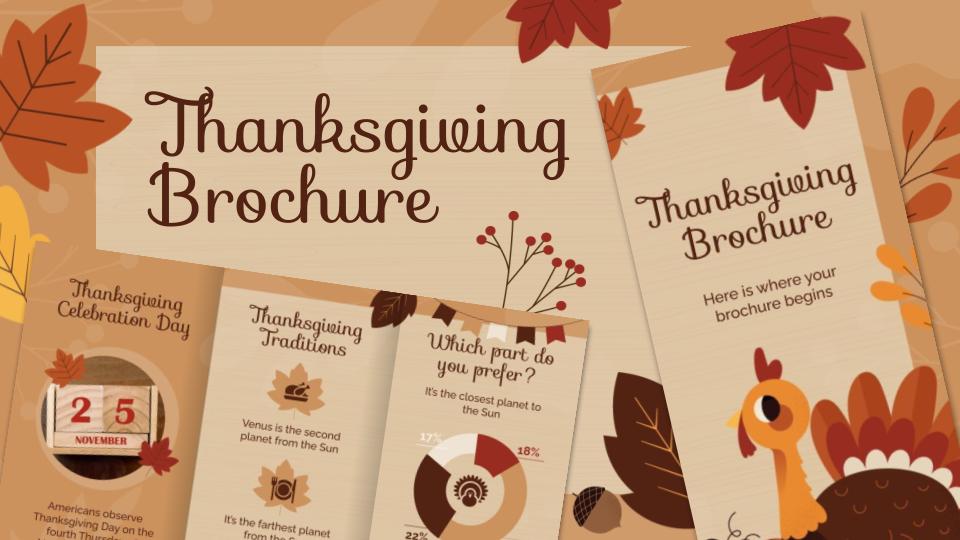
thankgiving
5 templates
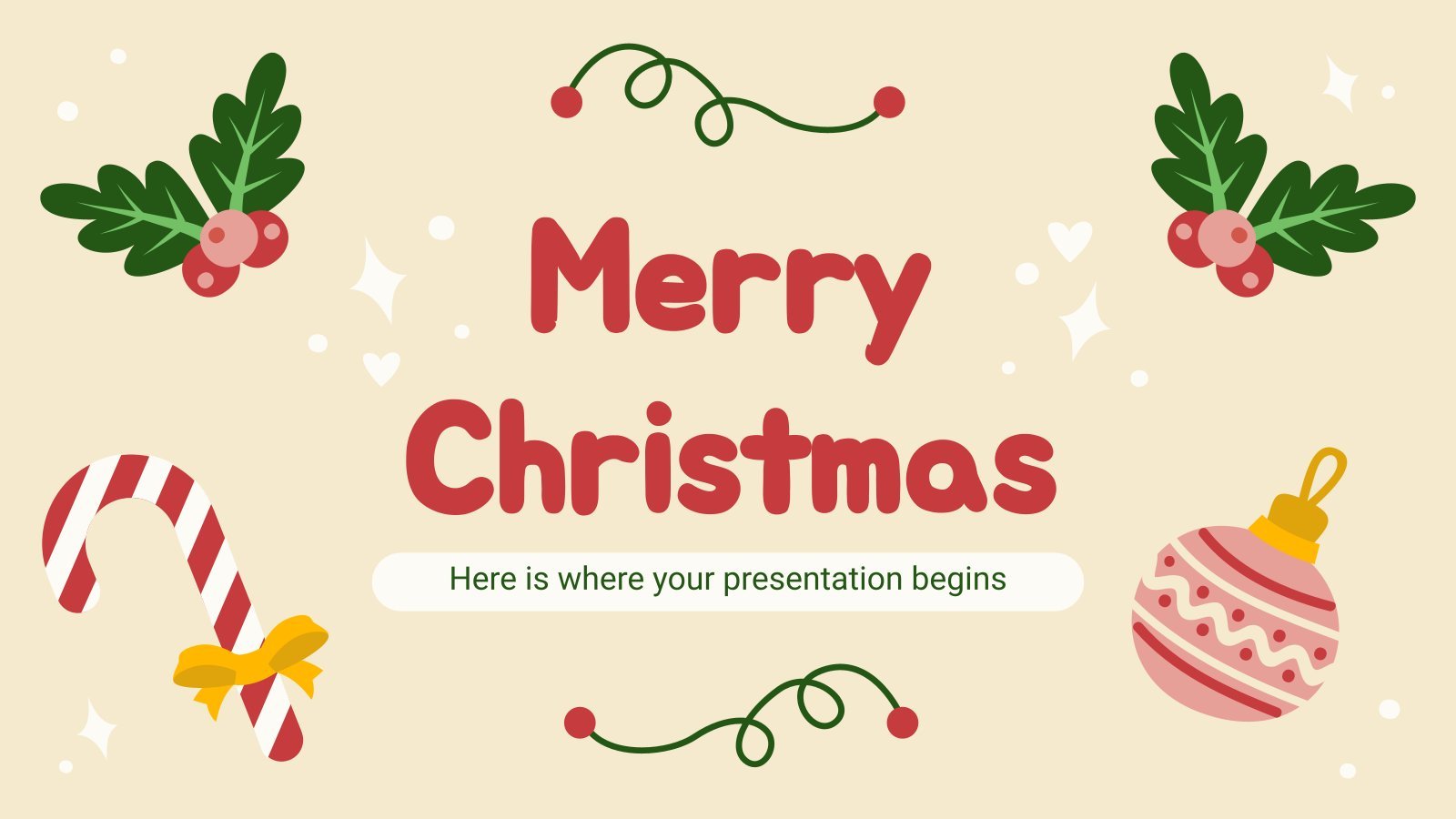
86 templates

tropical island
31 templates
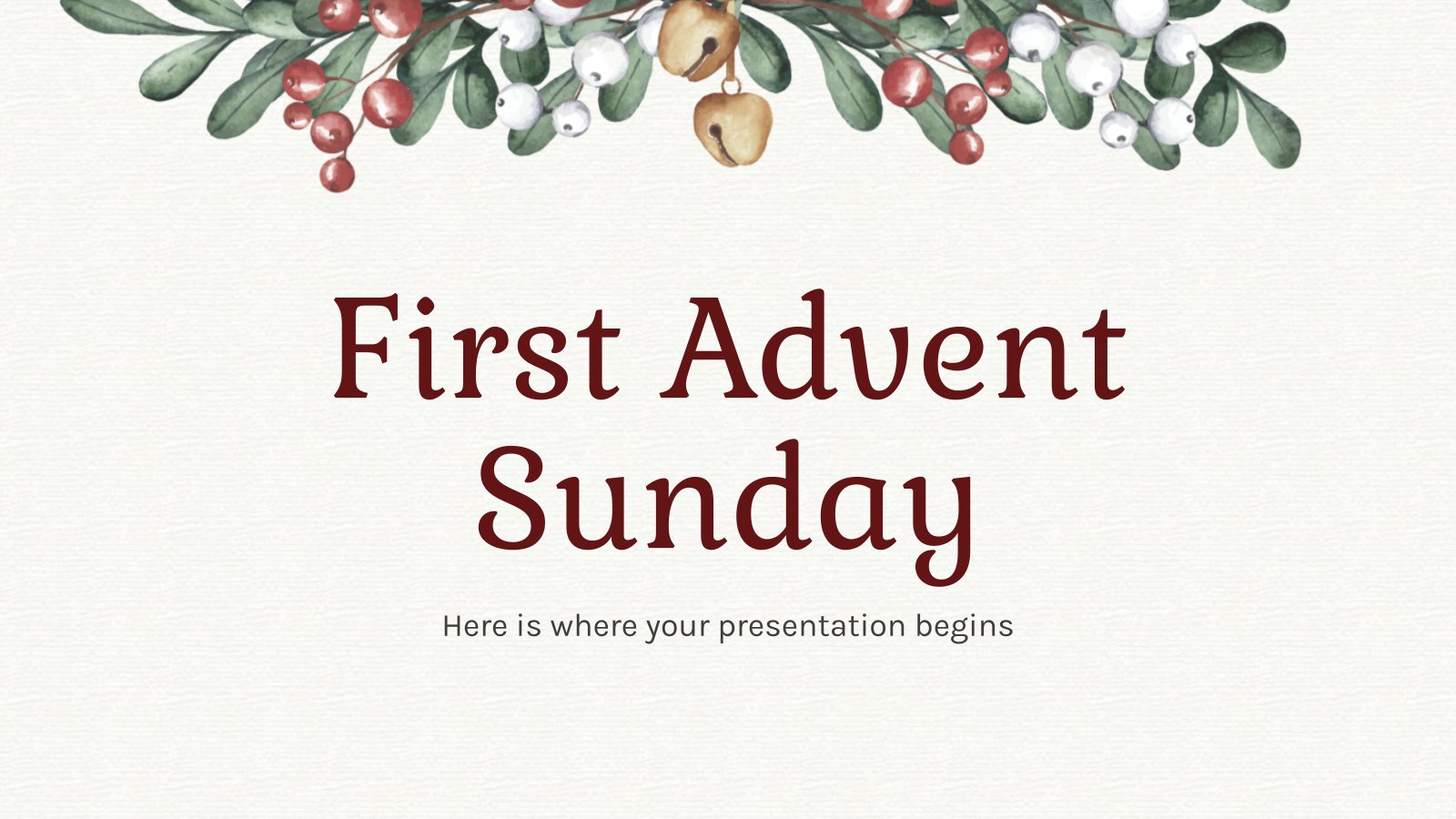
94 templates
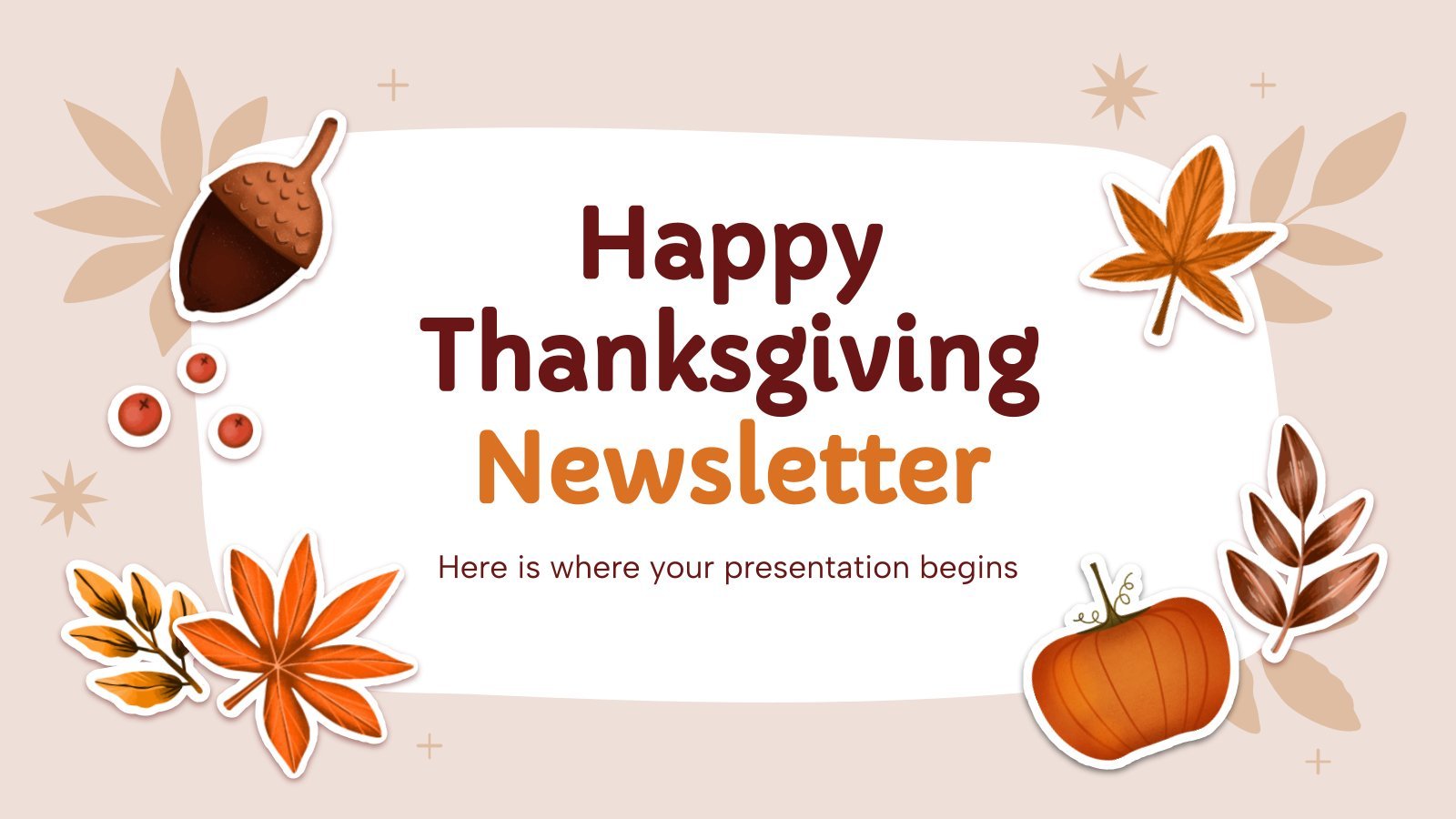
thanksgiving
60 templates
Verbs - English Grammar Lesson 1
It seems that you like this template, verbs - english grammar lesson 1 presentation, premium google slides theme, powerpoint template, and canva presentation template.
I played, you played, he played, we played... Wow, how easy the past simple of "play" is! You don't need to fear the verbs in English, there are languages who have it worse. In any case, this is what you were looking for, teacher! It offers an entertaining way of teaching not only verbs, but also adjectives, articles, nouns and more. Guess what, we've included several exercises with actual content so that you have some guidelines. Oh, and besides the design mimicking a notebook, there are animations! Let's end boring lessons once and for all!
Features of this template
- 100% editable and easy to modify
- 35 different slides to impress your audience
- Contains easy-to-edit graphics such as graphs, maps, tables, timelines and mockups
- Includes 500+ icons and Flaticon’s extension for customizing your slides
- Designed to be used in Google Slides, Canva, and Microsoft PowerPoint
- 16:9 widescreen format suitable for all types of screens
- Includes information about fonts, colors, and credits of the resources used
What are the benefits of having a Premium account?
What Premium plans do you have?
What can I do to have unlimited downloads?
Don’t want to attribute Slidesgo?
Gain access to over 30800 templates & presentations with premium from 1.67€/month.
Are you already Premium? Log in

Register for free and start downloading now
Related posts on our blog.

How to Add, Duplicate, Move, Delete or Hide Slides in Google Slides

How to Change Layouts in PowerPoint

How to Change the Slide Size in Google Slides
Related presentations.

Premium template
Unlock this template and gain unlimited access

Create your presentation Create personalized presentation content
Writing tone, number of slides.

Register for free and start editing online

IMAGES
VIDEO
COMMENTS
THE IMPERATIVE It has only one form, which is the same as the BASE form of a verb. Please be quiet. Come here. Go out. THE SIMPLE PRESENT TENSE The simple present tense of BE has three forms (am, is, are). The simple present tense of every full verb except Be has two forms. This is his photograph. They work in a hospital. Mary finishes work at 9.
What do helping verbs help to do? 3 Verbs 4 V ERB A verb expresses an action, a condition, or a state of being. 5 Verbs expressing an action, condition, or state of being. 6 A CTION V ERB An action verb expresses action, either physical or mental. The band marches onto the field. (physical action) The audience expects a great performance ...
There are three basic forms of verb tenses: past, present, and future. Simple and Perfect forms of these verbs are also used. The simple form of a verb demonstrates an action that has a specific time duration. The action has occurred, is going on now, or will happen in the future. The perfect form of a verb is used to show variations in time.
Verb To Be PowerPoints. Download these PowerPoints about the verb 'to be' and use them in class today! These PPTs are great for lessons teaching about the verb to be in the present and past tense. 'To be' is an irregular verb, and so its form is very different from other verbs in English. The verb 'to be' appears very often in ...
During download, if you can't get a presentation, the file might be deleted by the publisher. E N D . Presentation Transcript. Types of Verbs. ... An infinitive… • is a verb form. • will begin with "to" followed by the simple form of the verb like this: ...
A selection of English ESL verb form ppt slides. Log in / Register. Worksheets. Powerpoints. Video Lessons. Search. Filters. Browse Topics: Grammar Topics General Topics. 317 Verb form English ESL powerpoints. ... Verb forms presrent-This PowerPoint was . 612 uses. djg51qu. Chinese Festivals an. The student will lea. 26 uses. Herber. VERB TO BE ...
Verb Forms and Tenses. Three important forms Verbs in English have different forms which are used in the construction of tenses. • Three of the most important forms of any verb are • the base form: the "name" of the verb (e.g. be) • the past tense form: used in the simple past tense (to be discussed in just a minute) • the past ...
Helping verbs - words that work alongside the main verbs to add detail. Linking verbs - connect the subject of a sentence to a subject complement. Past, present, and future tense verbs - students understanding the tense is crucial for conveying when an action has occurred. Irregular verbs - these verbs don't follow standard rules, so ...
A ready to use lesson presentation that presents teaching and learning resources on tenses and verb forms. After completing this lesson, the students will be able to: Determine the structure of the verb forms in tenses. Relate verb forms in tenses to person and number. Demonstrate tense formulation and usage in writing.
Features of this template. Contains easy-to-edit graphics such as graphs, maps, tables, timelines and mockups. Includes 500+ icons and Flaticon's extension for customizing your slides. Designed to be used in Google Slides, Canva, and Microsoft PowerPoint. 16:9 widescreen format suitable for all types of screens.